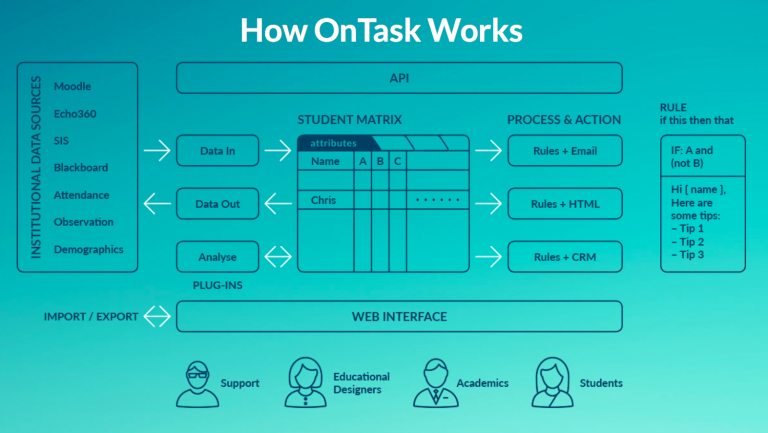
On May 22, UBC faculty and instructional support staff are invited to learn more about OnTask, a web-based learning analytics tool that’s currently being piloted as part of UBC’s Learning Analytics Project.
In this workshop, instructors will gain hands-on training with the OnTask platform, explore best practices for providing feedback to learners, and learn how to identify useful data. Please register in advance:
Using Learning Analytics to Provide Timely, Personalized, and Actionable Feedback to Learners
Chilcotin Room 256
Irving K Barber Learning Centre
1:30 p.m. – 3:30 pm
Tuesday, May 22, 2018
How OnTask works
OnTask uses data from online learning tools such as Canvas to enable instructors to provide targeted, customized messages based on the metrics they set for their courses. The tool includes a dashboard showing individual and aggregated student progress metrics and allows instructors to easily send custom email or text feedback to subsets of students who have yet to meet performance indicators, giving them a personalized reminder of what they need to do to catch up.
Here’s a sample message from the creators of OnTask that demonstrates the types of feedback instructors might want to provide to their students using this tool:
———————
Dear {{ first_name }}
Here are the comments about your answers to the midterm exam (ordered by topic).
Chemistry and Molecules of Life
{% if T1_LOW %}You need to review the concepts in this topic. It is important that you identify those molecules that are important in a living organism, and differentiate them from other molecules. Also, make sure you review the basic steps of the chemical reactions we discussed in class.{% endif %}
{% if T1_MID %}You need to review this topic again. Make sure you easily identify which molecules are present, for example, inside a cell and differentiate them from others.{% endif %}
{% if T1_HIGH %}Good work with this topic!{% endif %}
Cell Function and Structure
{% if T2_LOW %}Go back and review this chapter in depth. You need to be able to identify the parts of the cell, and more importantly, the role they play in the various functions. It may help to first build a table of these functions, then a table of the parts of the cell, and then a paragraph in each category connecting one element from each table.{% endif %}
{% if T2_MID %}Take some time to review cell function and structure. You confused some of the parts and need to make sure you understand all of the functions and the parts that participate in each of them.{% endif %}
{% if T2_HIGH %}Good work with this material! Can you envision how the cell gets the basic blocks for some of the functions such as DNA duplication?{% endif %}
Nutrition, Metabolism & Enzymes
{% if T3_LOW %}Take another thorough review of this block. You need to connect the elements required in the cell to perform nutrition processes with the components required, and more importantly, with the enzymes that regulate these processes.{% endif %}
{% if T3_MID %}Review this part a bit more. Look again at the various processes that comprise what we call the metabolism of the cell, and the role of each enzyme in these processes.{% endif %}
{% if T3_HIGH %}Good work with this block. Can you envision which metabolic processes will be affected if there are not enough nutrients reaching the cell? Can you think of any disease that is connected to these elements?{% endif %}
Your total score for the midterm is {{ mt_total }}.
Kind regards
{{ Coordinator_name }}
{{ course_name }}